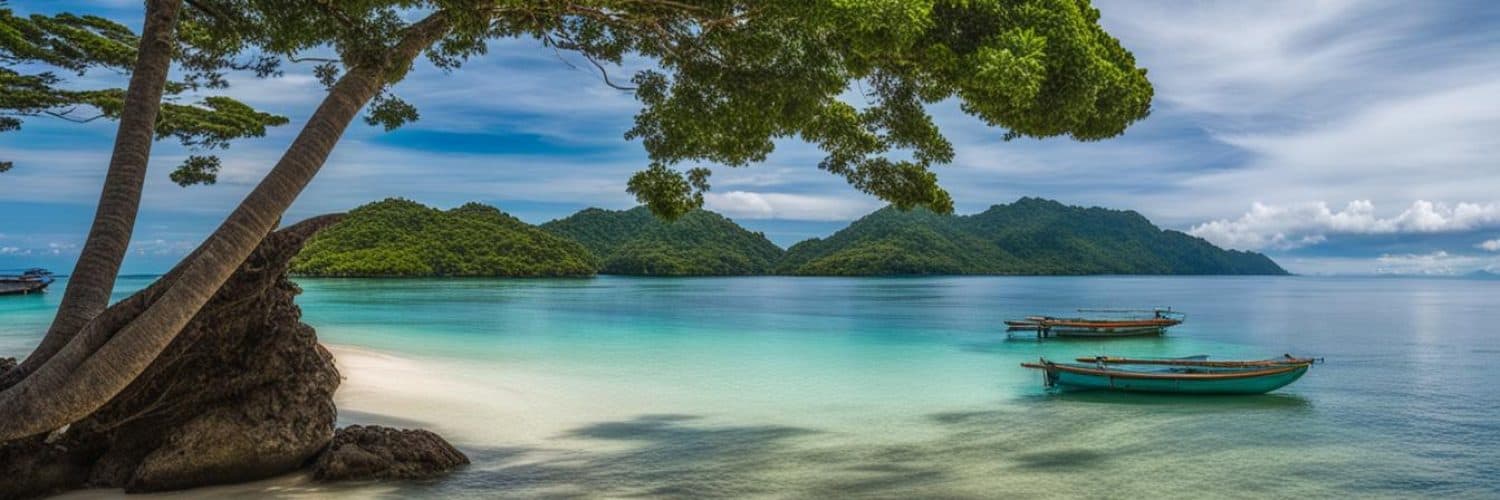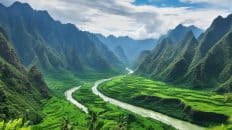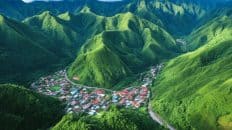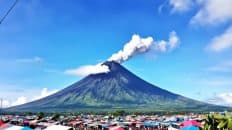Jolo Island, situated in the beautiful province of Sulu in the Philippines, is a hidden gem waiting to be explored. Known for its rich history, vibrant culture, and stunning natural attractions, Jolo offers a unique travel experience like no other. Despite concerns about safety, the provincial government of Sulu actively promotes Jolo’s beauty and charm, ensuring a safe and enjoyable visit for tourists.
With its volcanic landscape and a population of approximately 702,700, Jolo is an island that boasts both natural beauty and thriving industries. From fishing to agriculture, the local economy thrives on these sectors. Jolo’s diverse community speaks a mix of Banguingui, Bajau, Suluk/Tausug, Tagalog, and English, creating a melting pot of languages and cultural influences.
The best time to visit Jolo is during the dry season from November to April, with March to May being perfect for indulging in beach activities. However, it’s essential to book accommodations in advance, as the island tends to get fully booked during the peak season.
Dive into the wonders of Jolo and experience the true essence of this captivating destination.
Key Takeaways:
- Discover the hidden gem of Jolo Island in the Philippines.
- Experience the rich history, vibrant culture, and stunning natural attractions of Jolo.
- Jolo is safe for tourists, with the provincial government actively promoting its beauty.
- The best time to visit Jolo is during the dry season from November to April.
- Book accommodations in advance to ensure a comfortable stay on the island.
Getting to Jolo Island
Traveling to Jolo Island is an exciting adventure filled with intriguing scenery and cultural delights. While there are no direct flights to Jolo from Manila, Clark, Cebu, or Davao, reaching this captivating destination is still easily achievable.
If you prefer air travel, the best option is to fly to Zamboanga, which offers multiple flights from these major cities. From Zamboanga, you can choose between chartering a plane to Jolo or taking a flight via Sky Pasada. The convenience of air travel allows you to reach your final destination swiftly and comfortably.
Another option is to travel by ferry from Zamboanga to Jolo. You can enjoy the stunning views of the sea as you embark on a memorable journey. Overnight ferry and fastcraft options are available, providing flexibility for your travel plans. The ferry journey takes approximately 7-8 hours, while the fastcraft option allows you to reach Jolo in just 4 hours.
However, it is important to note that traveling to Jolo during the rainy season (June to October) is not recommended. This period carries a higher possibility of typhoons and transportation disruptions, which can affect your travel experience.
So, whether you prefer the convenience and speed of air travel or the scenic route via ferry, your journey to Jolo Island promises to be a memorable one.
Quotes:
“The journey to Jolo Island is an adventure in itself, allowing travelers to immerse themselves in the stunning scenery and vibrant culture of the Philippines.” – Travel Enthusiast
“Flying to Zamboanga and then taking a flight or ferry to Jolo is an excellent way to explore multiple destinations in the region.” – Adventure Seeker
Getting Around Jolo Island
When exploring Jolo Island, you have several options for getting around and experiencing all that this captivating destination has to offer. The main modes of transportation on the island include bicycles, motorcycles, and tricycles, providing a convenient way to navigate through the charming streets and vibrant neighborhoods.
However, it is important to coordinate with the Sulu Provincial Tourism office if you plan to explore Jolo independently. The tourism office requires tourists to submit a letter of intent, stating the reason for their visit, names of tourists, desired destinations, and duration of stay. This helps ensure the safety and well-being of visitors while also allowing the tourism office to provide assistance and guidance throughout their journey.
The Sulu Provincial Tourism office can help you organize personalized itineraries tailored to your interests, offering valuable insights into the best places to visit and things to do on the island. They can also arrange guides and police escorts to accompany you during your exploration, enhancing your experience and providing an added layer of security.
If you prefer a hassle-free and all-inclusive experience, you can opt for a tour package that includes transportation, fees, meals, guides, and even police escorts. This option allows you to sit back, relax, and fully immerse yourself in the beauty and culture of Jolo Island without worrying about the logistics and planning.
Whichever mode of transportation you choose and whether you decide to explore independently or with the assistance of the tourism office, Jolo Island welcomes you with open arms, ready to unveil its hidden treasures and provide you with an unforgettable adventure.
| Mode of Transportation | Pros | Cons |
|---|---|---|
| Bicycles | Eco-friendly option | Restricted to certain areas |
| Motorcycles | Flexible and efficient | Requires a valid license |
| Tricycles | Convenient for short distances | May need to negotiate fares |
Exploring Jolo Island is an opportunity to immerse yourself in its unique culture, encounter friendly locals, and be captivated by its breathtaking landscapes. Whether you choose to wander through the streets on a bicycle, feel the wind in your hair on a motorcycle, or enjoy a leisurely tricycle ride, each mode of transportation offers its own charm and allows you to deeply connect with the island and its people.
Must-Visit Attractions in Jolo Island
Jolo Island is a treasure trove of attractions waiting to be explored by visitors. From captivating historical landmarks to pristine beaches, there is something for everyone to enjoy. Here are some of the must-visit spots that should be on every traveler’s itinerary:
- Sulu Provincial Capitol: Marvel at the intricate Moorish-inspired architecture of the Sulu Provincial Capitol, which stands as an iconic symbol of the region’s rich history.
- NM Sulu Archipelago Area Museum: Immerse yourself in the captivating history and culture of Sulu and Mindanao at the NM Sulu Archipelago Area Museum, where you can discover fascinating artifacts and exhibits.
- Masjid Tulay: Pay a visit to Masjid Tulay, the largest mosque in the province, and witness its grandeur and religious significance.
- Jolo Cathedral: Visit Jolo Cathedral, a place of worship for Roman Catholics, and admire its stunning architecture and spiritual ambiance.
- Jolo Walled City: Explore the enchanting Jolo Walled City, known as the smallest walled city in the world, and immerse yourself in its rich historical heritage.
- Beautiful Beaches: Indulge in the pristine beauty of Maubo Beach, Istambak Beach, and Tanduh Beach, where turquoise waters and white sands create a picturesque setting for relaxation and water activities.
- Mount Datu: Hike up Mount Datu in the town of Indanan for breathtaking panoramic views of Jolo and the surrounding islets, offering a spectacular vantage point.
- Astana Darul Jambangan: Step back in time at Astana Darul Jambangan, believed to be the largest royal palace in the country and discover the fascinating history and cultural significance of this historical site.
- Nearby Islands: Explore the nearby islands of Bangas Island and Tapaan Island and revel in their natural beauty and unique attractions.
These are just a few highlights of the many attractions that await you in Jolo Island. Whether you are a history enthusiast, a nature lover, or a beach lover, there is no shortage of remarkable experiences to be had in this captivating destination.
Local Cuisine in Jolo Island
Jolo Island boasts a diverse selection of delicious local cuisine, offering a gastronomic experience that reflects the island’s rich cultural heritage. From traditional Tausug pastries to flavorful Islamic-inspired dishes, Jolo’s food scene is a true delight for food enthusiasts.
When visiting Jolo, make sure to stop by Shara’s Coffee Shop near the port. This charming eatery is renowned for its delectable Tausug pastries called bangbang and their signature black coffee known as Kahawa Sug. The combination of the flaky pastries and strong coffee is the perfect way to start your day on the island.
Lovelife Snack House is another popular food establishment in Jolo that you shouldn’t miss. Here you can savor a wide array of local delicacies, showcasing the fusion of Tausug and Islamic culinary traditions.
Some must-try dishes include Satti, a mouthwatering spicy grilled meat skewer that will satisfy your cravings for bold flavors. For a more hearty option, indulge in Tiula Itum, a rich and aromatic blackened beef or chicken soup. Another delectable choice is Piassak, which is a comforting beef stew cooked in creamy coconut milk.
Exploring Jolo’s local food scene is not just a culinary experience, but also an opportunity to immerse yourself in the island’s culture and traditions. The fusion of flavors and influences represents the unique identity of Jolo’s cuisine, making it an essential part of your travel guide to the Philippines.
Top Dishes in Jolo Island
| Dish | Description |
|---|---|
| Satti | A spicy grilled meat skewer, typically served with a savory peanut sauce and rice. |
| Tiula Itum | A flavorful blackened beef or chicken soup with a rich blend of spices. |
| Piassak | A succulent beef stew cooked in coconut milk, creating a creamy and savory dish. |
| Bangbang | Tausug pastries with a flaky texture, perfect for breakfast or an afternoon snack. |
| Kahawa Sug | A strong and aromatic black coffee that pairs perfectly with Tausug pastries. |
Traditional Weaving in Jolo Island
Jolo Island showcases a rich cultural heritage, and one of its notable traditions is traditional weaving. This time-honored craft has been passed down through generations, and it plays a vital role in preserving the island’s cultural identity.
The traditional textile known as Pisyabit is a true reflection of Jolo’s weaving heritage. Made from a combination of cotton and silk threads embellished with gold, Pisyabit is traditionally worn by Tausug men and is renowned for its intricate geometric patterns inspired by Islamic arts.
The local weavers, like Julmina Sawad Juri, are artists in their own right, dedicating their skills and expertise to maintaining the integrity of this ancient tradition. Their meticulous craftsmanship ensures that these carefully woven fabrics are of the highest quality, carrying the heritage of Jolo’s culture and traditions.
Furthermore, Jolo Island is not the only weaving community in the Philippines. The T’boli tribe and Yakan weavers from different regions of the country also contribute to the vibrant weaving scene in Jolo. Their unique textiles, such as T’nalak and Yakan fabric, showcase diverse weaving techniques and reflect the cultural diversity of the Philippines.
“Traditional weaving in Jolo Island is more than just a craft—it’s a living testament to the rich cultural heritage that has withstood the test of time.”
To truly immerse yourself in the local culture and support the invaluable art of traditional weaving, consider visiting the weaving communities, observing the meticulous process, and even purchasing these exquisite textiles as souvenirs of your visit to Jolo.
Through traditional weaving, Jolo Island continues to celebrate its cultural lineage and share it with the world, showcasing the intricate artistry and the vibrant tapestry that weaves together the past, present, and future of Jolo’s cultural identity.
Exploring Sultan Kudarat Province
Sultan Kudarat Province, located in the southwestern part of Mindanao, is a neighboring province of Jolo. This province offers a multitude of attractions that will captivate adventurous travelers seeking natural beauty and excitement.
One of the highlights of Sultan Kudarat Province is its stunning white sandy beaches. These pristine beaches provide the perfect setting for relaxation and sunbathing while enjoying the crystal-clear waters. Whether it’s swimming, snorkeling, or simply basking in the sun, the beaches of Sultan Kudarat are a must-visit for beach lovers.
For nature enthusiasts, the province boasts several spectacular natural attractions. Lake Buluan, a serene and picturesque lake, offers visitors the opportunity to engage in activities such as boating and fishing while taking in the breathtaking views of the surrounding landscape.
Adventure seekers can explore the majestic Makin Falls, which cascades down from a height of 25 meters. The refreshing spray of the falls and the lush surrounding greenery create a truly mesmerizing experience. Additionally, the Pitot Cave and Datalbao Cave offer thrilling spelunking adventures, allowing visitors to delve into the fascinating underground world of stalactites and stalagmites.
As you venture through Sultan Kudarat, be sure to visit Bamban Falls, a hidden gem tucked away in the province. The falls’ serene ambiance and pristine surroundings make it an ideal spot for picnics and photography.
Sultan Kudarat Province is not only blessed with natural beauty but also rich cultural heritage. To truly immerse yourself in the local culture, take the time to interact with the friendly locals and learn about their customs and traditions. Experience traditional dances, taste local delicacies, and visit historical landmarks to gain a deeper understanding of the province’s vibrant heritage.
With its abundance of natural wonders and cultural treasures, Sultan Kudarat Province is a must-visit destination for anyone exploring the southern part of the Philippines. Whether you are seeking adventure, relaxation, or a cultural experience, this province offers something for everyone.
Must-Visit Attractions in Sultan Kudarat Province
| Attractions | Description |
|---|---|
| White Sandy Beaches | A collection of stunning beaches with crystal-clear waters, perfect for relaxation and water activities. |
| Lake Buluan | A serene lake surrounded by lush greenery, offering boating and fishing opportunities. |
| Makin Falls | A majestic waterfall cascading down from a height of 25 meters, creating a mesmerizing spectacle. |
| Pitot Cave and Datalbao Cave | Thrilling spelunking adventures through fascinating underground limestone caves. |
| Bamban Falls | A hidden gem known for its serene ambiance and pristine natural surroundings. |
| Cultural Heritage Sites | Historical landmarks, traditional dances, and local delicacies showcasing the vibrant culture of Sultan Kudarat Province. |
Postal Codes in Jolo, Sulu
Jolo, being a part of Sulu Province, has several postal codes assigned to different areas within the island. These postal codes play a crucial role in ensuring accurate delivery and efficient communication within Jolo. By using the appropriate postal code, mail and packages can reach their intended destinations without any delays or errors.
Here are some of the postal codes for key areas in Jolo:
| Area | Postal Code |
|---|---|
| Jolo town | 7400 |
| Indanan | 7407 |
| Maimbung | 7409 |
| Talipao | 7403 |
These postal codes facilitate smooth logistics and enhance the overall communication infrastructure in Jolo. Whether you’re sending a letter, a package, or any other mail, using the correct postal code will ensure that it reaches its destination in a timely manner.
When addressing mail or coordinating deliveries in Jolo, it’s essential to include the correct postal code to avoid any potential delays or misdirection.
With the knowledge of the postal codes in Jolo, you can now navigate the island’s postal system confidently and effectively.
Conclusion
Jolo, Philippines is a captivating destination that offers a unique and unforgettable experience for travelers. Despite safety concerns, Jolo is actively promoting its beauty and charm. With its rich history, vibrant culture, and stunning natural attractions, Jolo has something for every visitor. From exploring historical landmarks and enjoying the pristine beaches to indulging in flavorful cuisine and admiring traditional crafts, Jolo provides a diverse range of experiences.
By following the recommended travel tips and guidelines, visitors can enjoy a safe and enchanting journey to Jolo. The island’s hidden gems, such as the Sulu Provincial Capitol, NM Sulu Archipelago Area Museum, Jolo Cathedral, and beautiful beaches like Maubo Beach and Istambak Beach, await exploration. Immerse yourself in Jolo’s culture by savoring local delicacies like Satti, Tiula Itum, and Piassak. Don’t miss the traditional weaving heritage of Jolo, exemplified by textiles like Pisyabit.
As you embark on your journey to Jolo, contribute to its growing tourism industry and discover the charm of this captivating destination. With its rich history, vibrant culture, stunning natural attractions, and traditional weaving heritage, Jolo, Philippines is a true gem waiting to be explored. So, create unforgettable memories, immerse yourself in the local culture, and enjoy the enchanting beauty of Jolo island.
FAQ
Is Jolo Island safe for tourists?
Despite its reputation for safety concerns, Jolo is actually safe for tourists, with the provincial government of Sulu actively promoting the island’s beauty and charm.
When is the best time to visit Jolo Island?
The best time to visit Jolo is during the dry season from November to April, with March to May being the ideal time for beach activities.
How do I reach Jolo Island?
What are the main modes of transportation in Jolo Island?
The main modes of transportation on Jolo Island are bicycles, motorcycles, and tricycles.
What are the must-visit attractions in Jolo Island?
Some of the must-visit spots in Jolo Island include the Sulu Provincial Capitol, NM Sulu Archipelago Area Museum, Masjid Tulay, Jolo Cathedral, Jolo Walled City, and the beautiful beaches of Maubo Beach, Istambak Beach, and Tanduh Beach.
What is the local cuisine like in Jolo Island?
The local cuisine in Jolo Island features influences from Tausug and Islamic traditions, with dishes like Satti, Tiula Itum, and Piassak.
What is the traditional weaving heritage in Jolo Island?
Jolo Island is known for its traditional weaving heritage, with the Pisyabit textile being a traditional garment worn by Tausug men. Local weavers play a vital role in preserving this rich tradition.
What are the attractions in Sultan Kudarat Province?
Sultan Kudarat Province offers attractions such as white sandy beaches, Lake Buluan, Makin Falls, Pitot Cave, Bamban Falls, and Datalbao Cave.
What are the postal codes in Jolo, Sulu?
Some of the postal codes in Jolo include 7400 for Jolo town, 7407 for Indanan, 7409 for Maimbung, 7403 for Talipao, and more.


















Add comment